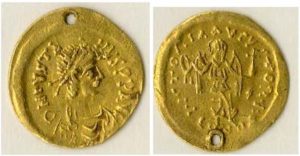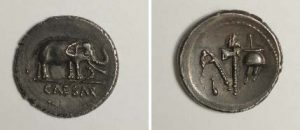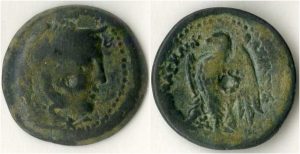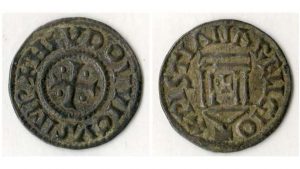
The Catholic University of America (CUA) coin collection, part of the museum administered by the American Catholic History Research Center and University Archives, contains nearly seventeen hundred numismatic pieces, primarily from ancient Greece, the Roman republic and empire, and Byzantium, as well as medieval and modern specimens, including coins from Western Europe, Persia, and China. A Roman poet once said: “Quidquid praecipies, esto brevis” (whatever you want to teach, be brief),¹ so let us begin.
From the late nineteenth century to as late as 1938, there were more than twenty donations, some 1682 coins. With the exception of the Nablus series, the collection was acquired entirely by gift. One of the earliest donations came from Claudio Jannet (1844-1894), a professor of Economics at Paris who also wrote about American political and economic institutions. He was known to be an admirer of the United States and probably interested in the establishment of CUA, hence the CUA Bulletin 1894 description of him as one of the University’s best friends who had donated a large collection of Greek and Roman coins. This donation of 806 coins represents the largest donation of the entire collection. Another early addition to the collection was 72 coins from Professor Henri Hyvernat and Msgr. Paul Muller-Simonis after their trip to India, 1888-1889. Hyvernat traveled extensively throughout the world and donated hundreds of eclectic items to the university museum from five continents.

The Nablus Collection, numbering 178 coins, came to the university in 1927 from the Samaritan Community of Nablus, Palestine, then under British administration. Due to its unique nature as a coin hoard discovered during an archaeological dig, Rev. Romain Butin, curator of the Museum and a professor of Semitics, had to obtain written permission from the High Commissioner of Palestine, and the Department of Antiquities, Jerusalem, to export the collection to CUA. There were also several other donations between 1916 and 1938. In 1975, CUA archivist George Hruneni created a preliminary inventory of the coins. In 1977, New York coin dealer Alex Malloy examined the collection, stating the overall quality was not superb, but with many good pieces it would be a valuable teaching aid. In 1987 a numismatist named John D. Mac Isaac reported that the Roman Imperial material was the overall strength of the collection, illustrating Roman art, economics, and political propaganda for the period 100 B.C. to 450 A.D. He also noted several coins he believed to be Greek forgeries and the presence of over 300 virtually illegible coins. The following year, Stephen Koob, an art conservator at the Smithsonian Institution, recommended improving the storage conditions of the coins. He also believed the collection would be a useful educational tool, providing tangible artifacts for the classroom, and, for some of the more valuable coins in good condition, as items displayed in exhibitions.

In 1991, volunteer students began transferring the coins from acidic envelopes and boxes to polyethylene sleeves housed in a series of binders to facilitate better storage and access. A student of Greek and Latin, Daniel Gordon, wrote a number of important notes on accompanying cards to individual coins in the collection. The coins are housed in the binders, usually ten (10) pages each in a covering box. Roman Empire coins dated 27 B.C. to 284 A.D., the accession of Diocletian, are listed as ‘early empire,’ those dated A.D. 284 to 476, the fall of the empire in the west, are designated ‘late empire.’ The first series contains the 806 coins donated by Jannet, collection number 1058, ca. 600 B.C.-1878 A.D., in binders 1-4. These are primarily Roman coins, but with a nice selection of Greek, Byzantine, Carthaginian as well as a few from Carolingian France. The second series has 31 coins donated by Grindell, collection number 2474, in binder 5. These are primarily Roman and Byzantine Coins, with one from Carthage. The third series has 115 coins donated by Pierre Court, collection number 2945, also in binder 5. These are primarily Roman coins. The fourth series, binder 6, has coins donated by Schrantz. The fifth series, binder 7, has coins donated by Ignatius Lissner. The sixth series, binder 8, has coins of poor quality from Luigi Gassi, designation no. 5281, consisting of 148 Roman, Greek, and Byzantine coins plus a no. 5282 Arabic coin. The seventh series, binder 9, has coins of the Nablus Collection. The eighth series, binder 10, has coins donated by Henri Hyvernat. The ninth and final series, binder 11, has miscellaneous coins donated by several sources.

In the past decade, Professor William Klingshirn of Greek and Latin has organized several classes of students for the purposes of examining specific categories of coins; learning how to properly weigh, identify and catalogue them; and consulting reference tools to compile new databases of portions of the coin collection for a more accurate inventory.² For more information on access, please contact lib-archives@cua.edu.
¹Horace (65-8 B.C.), Ars Poetica, 333.
²See the article by one of the CUA students: Lionel Yaceczko. “The Riddle of the Nablus Collection: An Unusual Hoard of Fourth-Century Roman Bronze Folles,” Studies in Late Antiquity 1.2 (2017), 173-203.
